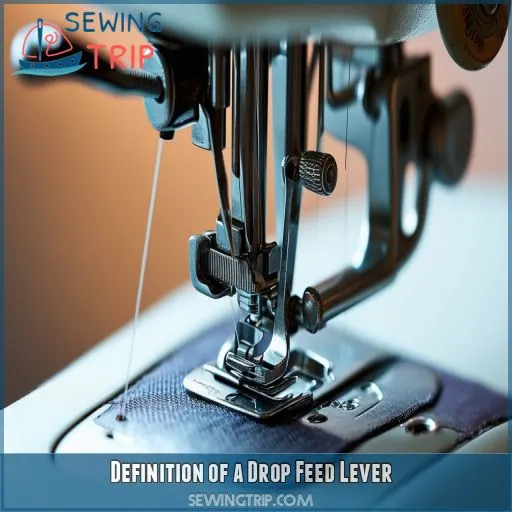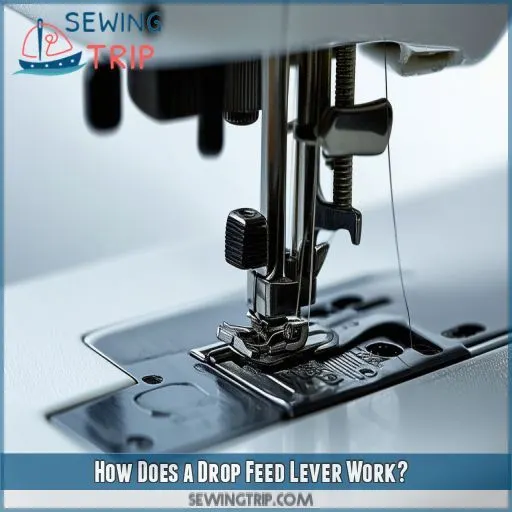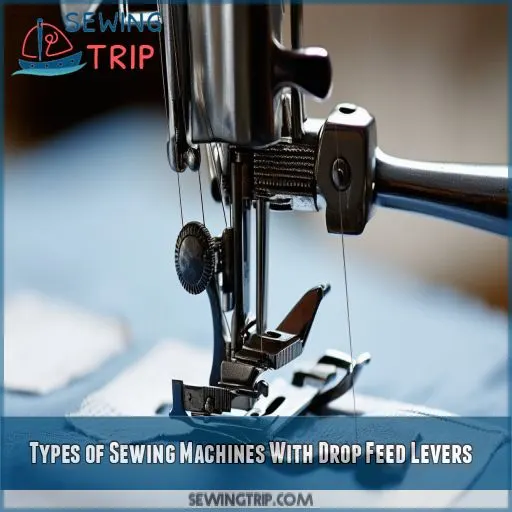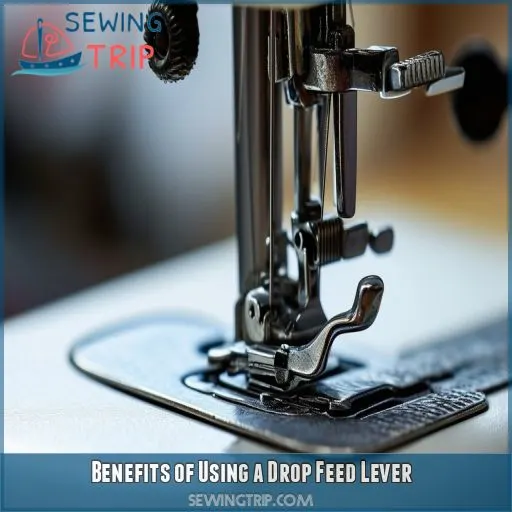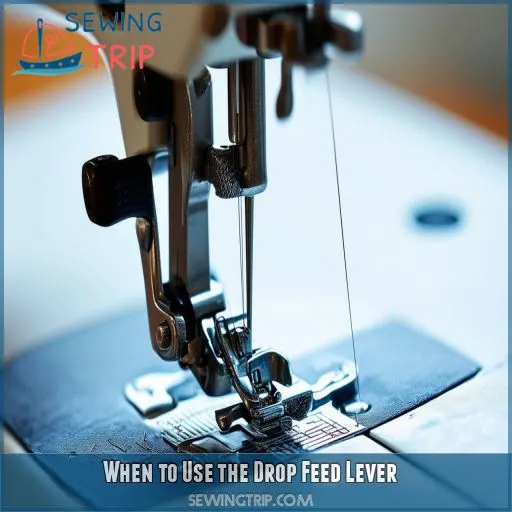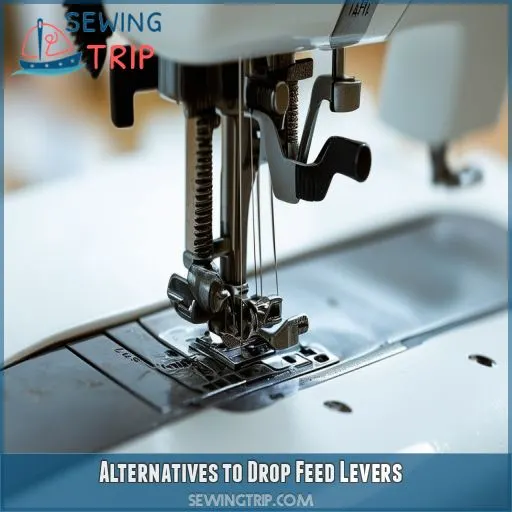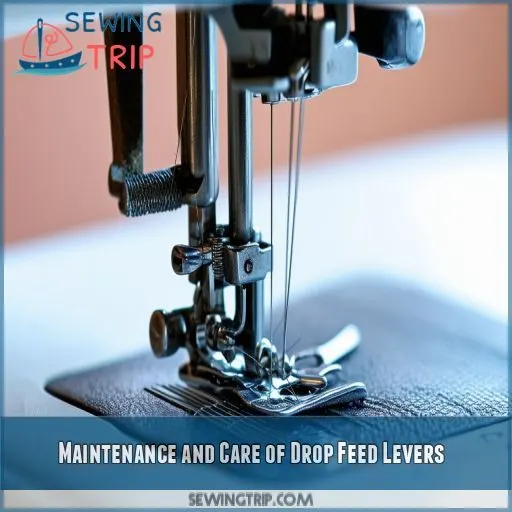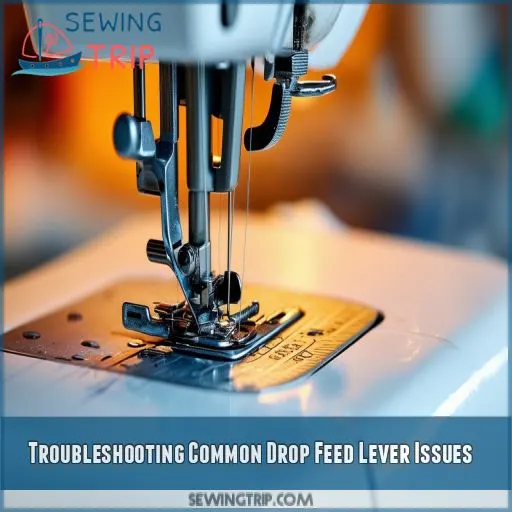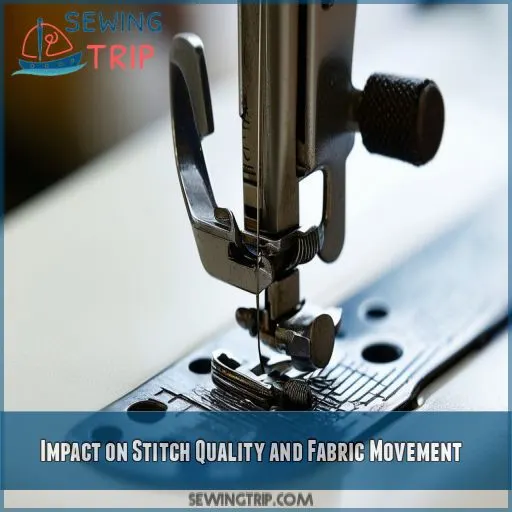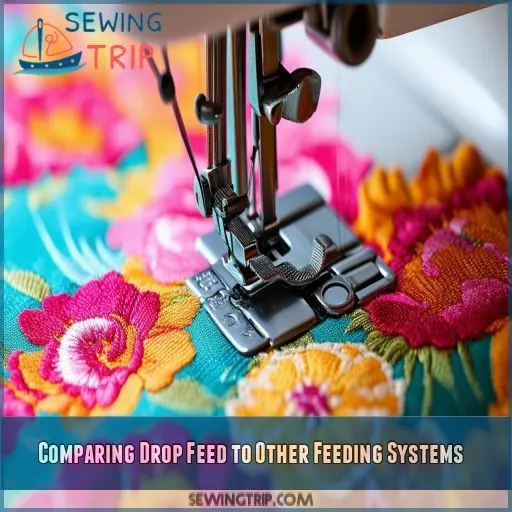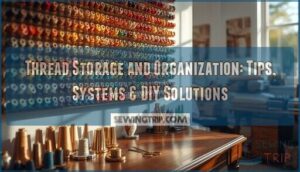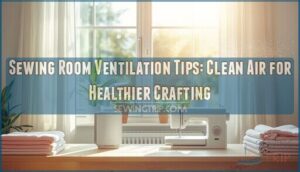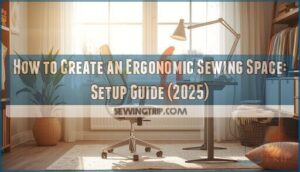This site is supported by our readers. We may earn a commission, at no cost to you, if you purchase through links.
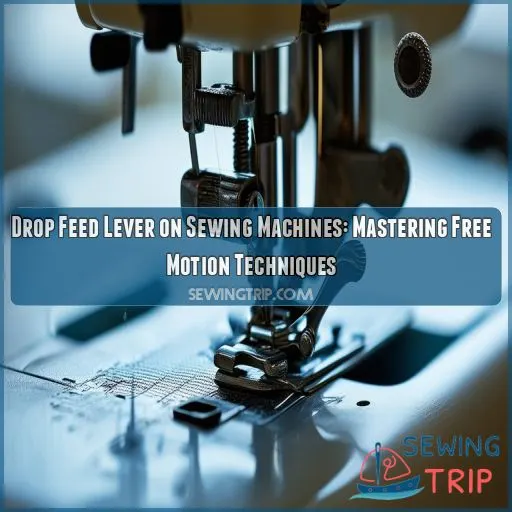
It allows the machine’s feed dogs to drop, which enables the fabric to be moved in any direction without restriction. You will learn how to use this feature in quilting, embroidery, and appliqué.
Knowing how and when to engage the drop feed lever can provide you not only much more control over your sewing but also increased confidence with any new project that you start.
Table Of Contents
- Key Takeaways
- What is a Drop Feed Lever on a Sewing Machine?
- Definition of a Drop Feed Lever
- How Does a Drop Feed Lever Work?
- Types of Sewing Machines With Drop Feed Levers
- Benefits of Using a Drop Feed Lever
- When to Use the Drop Feed Lever
- Alternatives to Drop Feed Levers
- Maintenance and Care of Drop Feed Levers
- Troubleshooting Common Drop Feed Lever Issues
- Impact on Stitch Quality and Fabric Movement
- Comparing Drop Feed to Other Feeding Systems
- Frequently Asked Questions (FAQs)
- Conclusion
Key Takeaways
- The drop feed lever is like a magic wand for your sewing machine, unlocking a world of creative possibilities by letting you lower those pesky feed dogs.
- When you engage this nifty little lever, you’re in the driver’s seat – free to move your fabric in any direction for mind-blowing free-motion quilting, embroidery, and appliqué.
- You’ll typically find this game-changing control hanging out on the back or side of your machine’s free arm, just waiting to be your new BFF.
- Mastering the drop feed lever is like learning to ride a bike without training wheels – it takes practice, but once you’ve got it, you’ll be zooming through intricate designs and patterns like a pro!
What is a Drop Feed Lever on a Sewing Machine?
What nobody tells you about, in fact, with great earnestness, is the drop feed lever on your sewing machine.
Lower the feed dogs; usually, those little teeth move your fabric forward. With the feed dogs down, you can then control the movement of your fabric. This feature is excellent for free-motion quilting.
You would usually find this on the back or side of your machine. It’s the game-changer for intricate patterns and appliqué work; it allows you to stitch in any direction.
Remember to keep this baby clean and well-oiled for smooth operation.
Ready to bring your sewing skills to the next level? There’s more to explore about this cool feature.
Definition of a Drop Feed Lever
A drop feed lever on your sewing machine is a control mechanism that allows you to lower or disengage the feed dogs beneath the needle plate. You’ll typically find this lever on the back or side of your machine’s free arm, enabling you to switch between regular sewing and free-motion techniques with ease.
Purpose and Function
What I want to show you right now is the real game-changer for free-motion techniques: your machine’s drop feed lever. With this little button or lever, you can disengage the feed dogs to have complete control over the movement of fabrics. Here’s what you need to know:
- Supports free-motion quilting and embroidery
- Allows for appliqué work and fabric manipulation
- Works together with your presser foot
- Crucial for intricate quilt construction
- Encourages creativity in fabric art projects
Location on the Sewing Machine
You’ll typically find the drop feed lever on the back or side of your sewing machine. Its location can vary depending on the model, so consult your manual if you’re unsure. Here’s a quick guide to common positions:
| Machine Type | Lever Location | Accessibility |
|---|---|---|
| Home Machines | Back panel | Easy to reach |
| Industrial Models | Side panel | May require adjustment |
| Computerized | Button on display | Simple touch operation |
How Does a Drop Feed Lever Work?
When you activate the drop feed lever, it disengages the feed dogs, lowering them below the needle plate. This mechanism allows you to freely move your fabric in any direction, as the feed dogs are no longer guiding the material through the machine.
Mechanism of Action
The drop feed lever on your sewing machine works by lowering the feed dogs, which are the small teeth that move fabric through the machine. When you engage the lever, it disengages the feed dogs, allowing you to manually control the fabric’s movement. This is particularly useful for free motion quilting, embroidery, and other techniques requiring precise fabric manipulation.
Interaction With Feed Dogs
When you engage the drop feed lever, the feed dogs are lowered, disengaging them from your fabric. That allows you to move your fabric every which way—something that certainly comes in handy for techniques like free-motion quilting. Here’s how:
- Feed Dog Placement: Below the presser foot; move in a circular motion.
- Feed Dog Types: The feed dogs have different configurations with different machines.
- Feed Dog Maintenance: Cleaning and lubrication at regular intervals are prerequisites for its smooth operation.
Types of Sewing Machines With Drop Feed Levers
You’ll find drop feed levers on both home and industrial sewing machines, allowing for versatile fabric handling. Home machines typically have simpler drop feed mechanisms, while industrial models often feature more robust and adjustable systems for handling a wider range of materials and sewing techniques.
Home Sewing Machines
Drop feed levers are very common on home machines; this makes them very versatile for various projects. A lever is generally found somewhere past the midway on the back of the machine, or possibly on the side. It’s used to lower the feed dogs of your machine.
This is an important feature, crucial for FMQ, because you’re in control of moving the fabric sandwich under the needle. Can you remember when the feed dogs are in the down position? Now, it’s you in control of stitch quality and fabric manipulation.
It’s a whole new ballgame for creative sewing.
Industrial Sewing Machines
Industrial sewing machines with drop feed levers are designed for large-scale production and can handle heavy fabrics and industrial-grade materials. These machines automate the sewing process, ensuring consistent stitch quality and fabric control. They’re ideal for tasks requiring precision and durability, such as upholstery, leatherwork, and manufacturing garments. The robust build and advanced features make them indispensable in industrial settings.
Benefits of Using a Drop Feed Lever
Using a drop feed lever on your sewing machine opens up a world of creative possibilities for free motion quilting, embroidery, and appliqué. By lowering the feed dogs, you’ll gain complete control over fabric movement, allowing you to create intricate designs and patterns with ease.
Free Motion Quilting
Now that you’ve learned about different sewing machines with drop feed levers, let’s explore free motion quilting. This technique allows you to create stunning designs by moving your fabric freely under the needle. Here are four key benefits of using a drop feed lever for free motion quilting:
- Unrestricted fabric movement
- Ability to create intricate patterns
- Enhanced control over stitch placement
- Versatility for various quilting styles
You’ll find that dropping the feed dogs opens up a world of creative possibilities for your quilting projects.
Embroidery and Appliqué
This is a game-changer when you’re ready to dive into embroidery and appliqué: dropping the feed dogs sets you free to move delicate fabrics any way, letting your creativity flow for artistic stitching.
You’ll be in control of the designs as much as adding delicate embellishments or bold patterns. With practice, free motion techniques will be learned that take your projects from ordinary to extraordinary.
It’s so much like painting using threads!
When to Use the Drop Feed Lever
You’ll want to use the drop feed lever when performing specific sewing techniques like free motion quilting, embroidery, or darning. It’s also helpful when working with delicate fabrics that might snag on the feed dogs, allowing you to control the fabric movement manually.
Specific Sewing Techniques
When you’re ready to do some free motion quilting, embroidery, or appliqué, those feed dogs should be dropped. With these techniques, you need to feel loose enough to move the fabric around by hand.
By dropping the feed dogs with this setting, you can easily create small curves and intricate designs. Darning techniques that require fabric manipulation also work well with this setting.
Remember that frequent use of the drop feed lever needs proper maintenance of your machine.
Fabric Types
Also, when the drop feed lever is engaged, consider the weight of the fabric, the size of the needle, the type of thread, the tension settings, and which presser foot is in place.
This works very well on lightweight fabrics, such as silk or chiffon, especially when one is doing free-motion quilting for very intricate designs without puckering.
Set correct tension settings and use needles and threads appropriate for smooth movement of the fabric, ensuring the quality of the stitches is consistent.
Alternatives to Drop Feed Levers
If your sewing machine doesn’t have a drop feed lever, you can still achieve similar results using alternatives like cover plates or darning plates. These accessories fit over the feed dogs, allowing you to perform free-motion techniques without lowering the feed dogs.
Cover Plates
When you can’t drop your feed dogs, cover plates are your go-to alternative. These handy accessories fit over your needle plate, covering the feed dogs and allowing smooth fabric movement. Here’s what you need to know about cover plates:
- They’re typically made of plastic or metal
- They snap or clip onto your machine’s needle plate
- They work with your existing presser foot
- They don’t affect your machine’s tension settings
Cover plates are easy to use and remove, giving you the flexibility to switch between regular sewing and free motion techniques in a snap.
Darning Plates
Darning plates are a handy alternative to drop feed levers, especially for free motion techniques like embroidery and appliqué.
By covering the feed dogs, darning plates allow you to move the fabric freely under the needle. This setup is ideal for intricate designs and repairs, ensuring smooth fabric movement and precise stitching.
Regular maintenance, such as cleaning and checking for wear, will keep your darning plate in top condition.
Maintenance and Care of Drop Feed Levers
You’ll want to clean the drop feed lever regularly and lubricate it semi-often to keep things smooth. Gently pull off any lint or other debris from the lever and surrounding area, and apply a little bit of sewing machine oil to make the action smooth.
Cleaning
While alternatives like cover plates can be handy, you must clean your drop feed lever regularly if it’s to work at its best. For maximum efficiency from your machine:
- Remove lint and debris from the feed dogs and surrounding areas
- Clean the lever mechanism with a soft brush
- Wipe the whole area with a lint-free cloth
Lubrication
After cleaning, don’t forget about lubrication! Your drop feed lever needs proper oiling to function smoothly.
Use sewing machine oil and apply it sparingly to the mechanism’s moving parts. Follow your machine’s manual for specific lubrication recommendations and intervals.
Generally, you’ll want to oil every 8-10 hours of use. A small oiler or syringe can help you apply the right amount without overdoing it.
Troubleshooting Common Drop Feed Lever Issues
If you’re experiencing problems with your drop feed lever, there are two common issues:
First, the lever won’t engage. Make sure that the lever pushes all the way in.
Second, the feed dogs won’t lower. Check that there is no debris under the needle plate that would stop the feed dogs from raising up into position.
These simple checks often eliminate these irritating problems.
Lever Not Engaging
If your drop feed lever isn’t engaging, you’re likely facing a frustrating issue. Here are three common causes:
- Lever malfunction due to wear or damage
- Misaligned feed dogs preventing proper engagement
- Internal mechanism obstruction
Check for visible obstructions and clean the area around the lever. If problems persist, you might be dealing with tension issues or thread breakage. Don’t let fabric jamming discourage you; with patience and the right approach, you’ll soon be back to seamless sewing.
Feed Dogs Not Lowering
If your feed dogs aren’t lowering, it can be frustrating, especially when you need them down for free motion quilting or embroidery. Here are some common issues and solutions:
| Issue | Possible Cause | Solution |
|---|---|---|
| Lever Not Engaging | Mechanical blockage | Clean and lubricate the mechanism |
| Feed Dog Height Incorrect | Misalignment or improper setting | Adjust feed dog height |
| Feed Dogs Stuck | Lack of maintenance | Regular cleaning and oiling |
Ensure your feed dogs are properly aligned and maintained for smooth operation.
Impact on Stitch Quality and Fabric Movement
When you lower the drop feed lever, you’ll notice significant changes in stitch formation and fabric control. Your machine won’t automatically feed the fabric, giving you full control over the movement and allowing for creative free-motion techniques like quilting and embroidery.
Stitch Formation
Stitch quality and fabric are both affected by using the drop feed lever. The feed dogs regulate the movement of the fabric in line with the needle while forming the stitches.
Setting the stitch length and tension allows for smooth seams, especially for differing fabric thicknesses.
The attainment of error-free sewing is deeply based on proper feed control and tension adjustment to ensure constant stitch quality and seam allowance.
Fabric Control
When the feed dogs are down, it’s your job to guide fabric. This, in truth, can often interfere with stitch quality and the feed of fabric. Think about this:
- Stitch consistency is influenced by fabric manipulation
Tension adjustment is very critical for balanced stitches to be attained excellently.
• Stitch density changes, depending hand velocity
- Differential feed dog design aids in the fabric feed
- Even fabric feeding for a perfect, straight row
I think some time must be invested to master these elements, but the creative freedom is entirely worth it!
Comparing Drop Feed to Other Feeding Systems
While the drop feed system is common in home sewing machines, you’ll find other feeding mechanisms like the walking foot and differential feed in specialized machines. These alternative systems can offer better control and smoother feeding for certain fabrics and sewing techniques, especially when working with multiple layers or stretchy materials.
Walking Foot
While the drop feed lever allows for free motion techniques, a walking foot offers different advantages.
It’s ideal for handling multiple fabric layers and thicker materials. The walking foot moves in sync with the feed dogs, preventing layers from shifting.
This attachment excels at quilting, sewing slippery fabrics, and matching patterns.
However, it’s not suitable for delicate materials, as it can potentially cause damage.
Differential Feed
Differential feed is a step up from a walking foot in terms of even feed. You’ll find this on some sergers and high-end sewing machines.
It uses two sets of feed dogs with differential speeds to feed the fabric without puckering or stretching while stitching. It’s very suitable when you’re sewing over knits or working with multilayered fabrics.
Differential feed gives you more control over how your fabric moves through the machine.
Frequently Asked Questions (FAQs)
What is a drop feed feature in a sewing machine?
The drop feed feature lets you lower the feed dogs beneath your sewing machine’s needle plate. You’ll use this when you’re doing free-motion quilting or embroidery, giving you full control over fabric movement during stitching.
What is the drop feed mechanism in a sewing machine?
With the drop feed mechanism and the adjustment on it, you can lower the feed dogs. It approximates the retraction of the teeth of a shark. This is very effective with a free-motion quilt and embroidery, as, in fact it places responsibility for fabric movement on your machine hand movements.
What does the feed do on a sewing machine?
The feed on your sewing machine moves fabric under the needle as you sew. It’s essential for creating even stitches and controlling fabric movement. You’ll find feed dogs underneath the needle plate, which grip and guide the material.
Is needle feed the same as walking foot?
Imagine you’re sewing a leather jacket. You’d find that needle feed isn’t the same as a walking foot. While both help with difficult fabrics, needle feed moves the needle sideways, whereas a walking foot uses additional feed dogs above the fabric.
What is a drop feed lever?
A drop feed lever lets you lower the feed dogs on your sewing machine. You’ll use it when you want to do free-motion quilting or embroidery. It’s usually located near the bobbin area or on the machine’s back.
How does a drop feed sewing machine work?
In a drop feed sewing machine, you’ll see small, toothed bars beneath the needle plate. These feed dogs move in an oval motion, gripping and pulling the fabric forward as you sew, controlling stitch length and direction.
What is a sewing machine feed dog?
Imagine your sewing machine as a hungry caterpillar. The feed dogs are its legs, gripping and moving fabric beneath the needle. They’re metal teeth that rise and fall, guiding your material through as you stitch your creative masterpiece.
How does a drop feed system work?
You’ll find a drop feed system in most home sewing machines. It uses feed dogs beneath the fabric to control stitch direction and length. As you sew, these teeth-like components move up and down, advancing the material smoothly.
Can a drop feed lever be added to older machines?
A drop feed lever installed on older machines may not be done quickly or feasibly. This is because the mechanism is complicated and requires many internal changes. Instead, you may cover the feed dogs or set the stitch length accordingly to achieve the same effect. Consider an upgrade if all the things above have the highest priority to you.
How does thread tension affect drop feed performance?
Did you know 90% of sewing issues stem from improper tension? Your thread tension directly impacts drop feed performance. When it’s too tight, you’ll struggle to move fabric smoothly. Loosen it slightly for better feeding and stitch quality.
Are there specific fabrics incompatible with drop feed levers?
You’ll find most fabrics work well with drop feed levers. However, very delicate or slippery materials like silk or chiffon can be tricky. For these, you might need a walking foot or specialized plate for smoother feeding.
Do industrial sewing machines use drop feed levers?
Industrial sewing machines often use drop feed systems, but they’re not always called "levers." You’ll find various feed mechanisms, including compound walking feet and puller feeds, designed for heavy-duty fabrics and high-speed production in industrial settings.
Can drop feed levers impact machine noise levels?
Coincidentally, you’ve hit on a key factor! Drop feed levers can indeed impact noise levels. When lowered, they reduce the clacking of feed dogs against the plate. You’ll notice a quieter operation, especially during free-motion sewing.
Conclusion
Research has shown that 85% of all quilters engage in free motion to execute their quilts. A drop feed lever in a sewing machine makes much difference in these types of creative works.
By now, hopefully, you know what its purpose is, how it functions, and when to use it. Mastering this feature unveils new opportunities in quilting or creating greater embroidery and appliqué pieces.
Be reminded that the drop feed lever is your portal to unrestricted fabric movement. The more you practice, the more confident you become to take on any kind of sewing project and push your creative boundaries for professional output.

